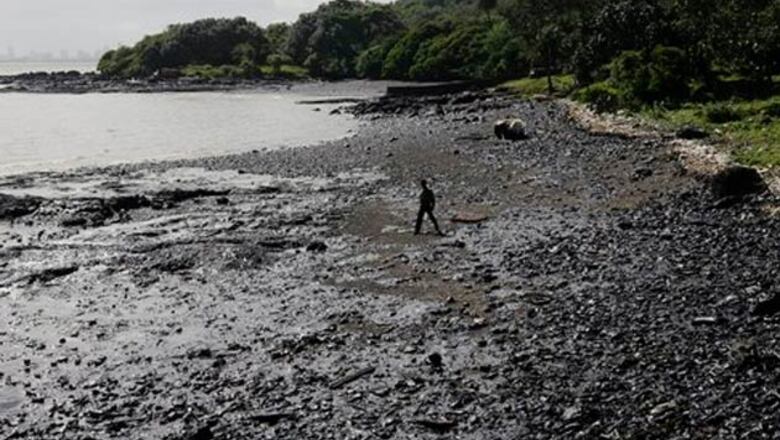
views
When the MSC Napoli, a container ship, was beached off the coast of Cornwall in England three years ago, not everyone was distressed by the tonnes of bunker oil from the ship's tanks making its way to the shore. With the oil slick, the tide also brought in containers filled with all manner of goods including BMW motorcycles and automobile spares. Police had to be brought in to patrol the shores, as people made off with the goods, adding to the difficulty of dealing with the ship and the oil on the beaches. The collision between container ship MSC Chitra and MV Khalijia off Mumbai on August 7, 2010 has some similarities with the Cornwall incident. Here too, people foraged around for packets of chocolates and other goods washed ashore.
Oil spills, especially those that take place on water, have more in common than the propensity of locals to make off with stuff that comes their way. Increased offshore drilling and transportation of fuel by tankers across greater distances has led to a gradual increase in the number of incidents over the years. The odds of something going wrong have gone up because companies are venturing into more difficult areas to find the oil. The big difference between spills in the past and now is that a major accident could cost billions of dollars to deal with. British oil company British Petroleum, whose leaking Macondo well put close to a million tonnes of crude oil into the Gulf of Mexico in three months, is looking at clean-up costs and claims that could go up to $30 billion — an amount that could well take the company to the cleaners.
One way to deal with such incidents is to assess the risks regularly and prepare to respond quickly in an eventuality, says Sudhir Vasudeva, ONGC's director for offshore operations.
Oil Spill Response (OSRL), a company now owned by 36 oil majors including ONGC, was formed to do exactly this. Over 25 years of its existence, the not-for-profit organisation, has become the first point of contact for almost all oil-spills. It employs about 150 experts divided between three bases in Southampton, Singapore and Bahrain and carries a $50 million inventory of equipment including aircraft that can spray dispersants, ready for deployment in an emergency. Most of these experts have attended to at least 10 oil spills; some like Daniel Chan have dealt with several more. Chan is deputy operations manager in Singapore, and is leading the first team on the Mumbai spill.
Spill Co-operative
A key aspect of their job is to identify the nature of the spill and figure out how to minimise the impact. But this can often be complicated by circumstances peculiar to the incident. In Mumbai for instance, the response team discovered that some of MSC Chitra's falling containers contained canisters full of pesticides, which if cracked would release phosphine, a toxic gas. Many of these washed onto beaches at Elephanta Island and Alibag. Responding quickly, the group was able to figure ways to prepare for the increase in toxicity levels around the ship. They set up gas monitors to check air quality and built an advance medical post on the island, putting in capability to deal with people impacted by the gas. Fortunately, the need did not arise as most of the canisters were retrieved.
Spill response teams working at BP's Macondo well too had to deal with similar problems. The crude oil gushing out at the bottom of the sea contained gas, which released toxic vapours when it reached the surface. Engineers trying to drill an alternate well to reduce the pressure from the gusher at the bottom of the sea could not get close enough to work at the site. They had to respond quickly by spraying dispersants on the surface of the water to lower the gas concentration. They were also provided breathing apparatus to get closer to the leak without being in harm's way.
"As oil companies go further and deeper in search of oil, they have to train to respond in harsh terrains and bad weather," says Thomas Liebert, global head of operations for OSRL. They are advising Cairn plc on building spill-response capacity in Greenland, where the Scottish company is now drilling exploratory wells.
Liebert says spill response work is time consuming and can be very tough in remote areas. In an incident very similar to the BP spill, when the Montara oil platform in the Timor Sea off Indonesia blew out in late 2009, it leaked oil for almost three months. It did not attract as much global attention because it occurred virtually in No Man's Land — a part of the sea shared by East Timor, Indonesia and Australia. The only way to contain the slick, spread over 3,000 square kilometres at sea, was to put booms (floating barriers) around the largest parts and start scooping up the top layer of oil and water. To achieve this was no mean task. Teams of response experts had to spend weeks at sea, trying to find the slicks and then trap them in the booms. "Fortunately for us, the oil was waxy and formed a thick, chocolate mousse-like layer over the water. Since the patch was thick, it stayed together and could be chased and contained into the booms," says Liebert.

















Comments
0 comment